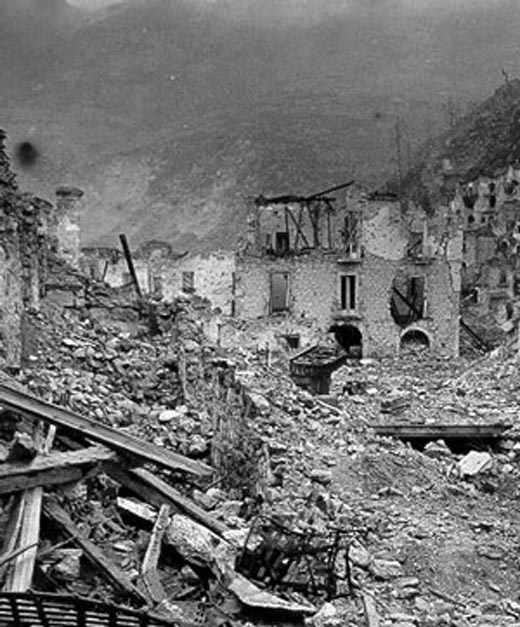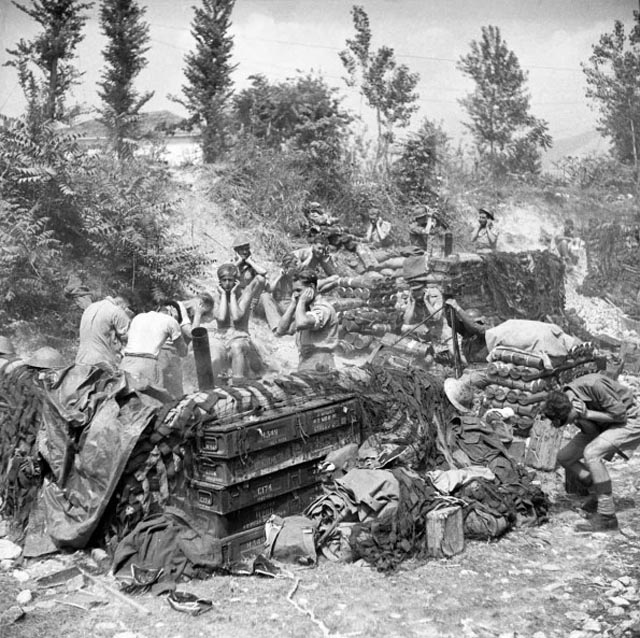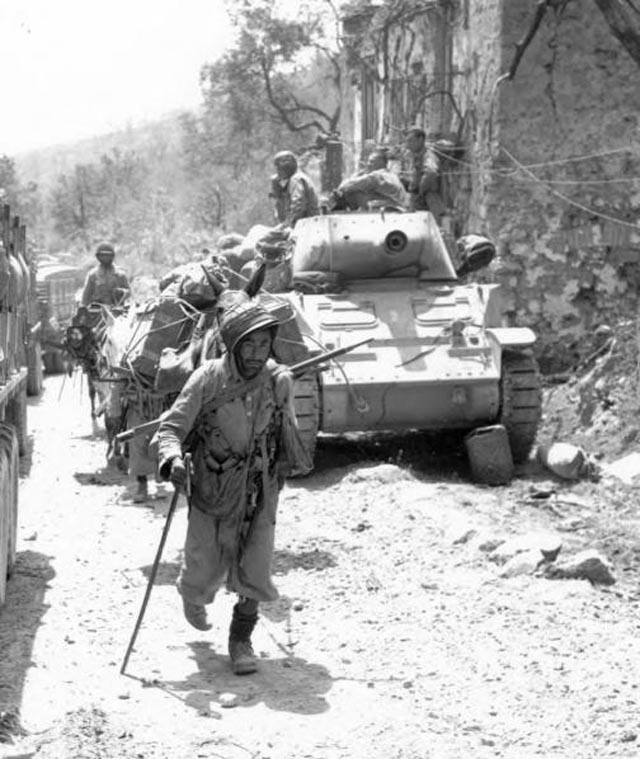Air Operations, CBI
BURMA- 14 7th Heavy Bomb Group B-24s attack rail facilities at Maymyo.
- 12 10th Air Force B-25s attack rail facilities in the Sagaing-Shwebo area.
- 12 B-25s attack bridges spanning the Pyu River.
- 24 A-31s attack Japanese Army positions at Labawa and near Maungdaw.
- More than 70 B-25s and fighter-bombers attack targets in the Mogaung Valley.
- 24 P-51s attack the airfields at Anisakan, Heho, and Meiktila.
- P-51s of the 311th Fighter Groupís 530th Fighter Squadron down 13 Japanese fighters over Meiktila airfield and near Mandalay between 0900 and 0940 hours.
- 24 14th Air Force P-40s attack numerous targets in southern China and northern French Indochina.
- 6 341st Medium Bomb Group B-25s and 24 14th Air Force P-40s attack rail facilities at Sinyang, a warehouse near Sinyang, and a freighter and smaller vessels between Chienli and Siaokan.
- 2 B-25s and 4 P-40s attack Japanese Army tanks, motor vehicles, and ground troops.
- 6 CACW P-40s attack supply dumps at Mienchih.
- 13 P-40s attack Yangtze River traffic near Hosueh.
- 3rd CACW Fighter Group P-40ss down 6 Ki-43 'Oscar' fighters over Mienchih and the Yellow River between 1220 and 1250 hours.
- A 76th Fighter Squadron P-51 downs an 'Oscar' fighter in an afternoon engagement over Namyung.
- Chinese Army ground forces cross the Salween River in two places and begin advancing through heavily defended terrain with the aid of 14th Air Force combat and resupply aircraft.
- 36 10th Air Force A-31s attack Japanese Army positions at Kohima and Potsangbam.
Air Operations, East Indies
380th Heavy Bomb Group B-24s based in Australia attack the Laha airfield on Ceram and the Namlea airfield on Boeroe.
[Air Operations, Europe
Oberst Walter Oesau, a fighter 'ace' with 123 victories, is shot down and killed over the Eifel Mountains. The 9th Air Force begins a series of raids on airfields around Caen. The Lancaster 'S for Sugar', of RAF No 467 Squadron, completes its 100th mission.
RAF BOMBER COMMANDEvening Ops:
- 190 Lancaster and 8 Mosquitos of No. 5 Group and 3 Mosquitos of No. 8 Group are sent to attack a large military camp at Bourg Léopold in Belgium. Haze hampers the marking of the target and the Master Bomber orders the bombing to be abandoned for fear nearby housing will be hit. This is after 94 Lancaster have already dropped their loads.
- 5 Lancasters are lost.
- 135 aircraft of Nos. 6 and 8 Groups are sent to Boulogne. Included in this total are 80 Halifaxes, 47 Lancasters and 8 Mosquitos. Some bombs fall in the railway yards, but the majority misses the target and falls on neaby civilian housing. 128 people are killed.
- 2 Halifaxes are lost.
- 126 Lancasters and 6 Mosquitos of Nos. 1 and 8 Groups are sent to Hasselt in northeastern Belgium. The target is marked and 39 aircraft drop their bombs, but all miss the railway yards because of thick haze and the Master Bomber orders the bombing to stop.
- 5 Lancasters are lost.
- 105 Lancasters and 5 Mosquitos of Nos. 3 and 8 Groups attack the railway yards at Louvain near Rennes. The main bombing hits the workshops and nearby storage buildings.
- 4 Lancasters are lost.
- 53 Halifaxes of No. 4 Group and 6 Pathfinder Mosquitos attack a gun position at Colline Beaumont near Le Touquet. The target proves difficult to mark and no results are established.
- There are no losses.
- 12 aircraft lay mines off French ports, 3 aircraft are on Resistance operations, and there are 8 RCM sorties and 6 Serrate patrols.
- There are no losses.
ETO:
- Escort for various 8th Air Force afternoon B-17 targets in France, Belgium, Germany, and Luxembourg is provided by 471 VIII and IX Fighter Command fighters.
- 4 fighters are lost with their pilots
BELGIUM:
- During the afternoon, 104 8th Air Force B-17s attack two marshalling yards in Brussels.
- 119 B-17s attack the marshalling yards at Liege.
- 20 B-17s, unable to attack their briefed targets attack the rail junction at Malines.
- 2 B-17s are lost.
- Despite cloudy conditions, a total of 195 2nd Bomb Division B-24s attack the marshalling yards at Belfort, Espinal, and Mulhouse, as planned.
- 99 2nd Bomb Division B-24s attack various targets of opportunity.
- 70 3rd Bomb Division B-17s dispatched against the marshalling yard at Chaumont fail to reach the target.
- 6 B-24s are downed by flak, 2 are interned in Switzerland
- Escort and support for the 2nd Bomb Division is provided by 536 VIII Fighter Command fighters.
- 5 fighters are lost with their pilots
- During the afternoon, 12 8th Air Force B-17s unable to reach their briefed primary attack the marshalling yard at Thionville.
- 78th Fighter Group P-47 pilots down 3 Luftwaffe fighters over France between 1410 and 1445 hours.
- During afternoon missions by 8th Air Force B-17s, 19 attack a marshalling yard at Bettembourg, 60 attack a marshalling yard at Ehrgang, 55 attack a marshalling yard at Kons Karthaus, 58 attack a marshalling yard at Saarbrucken, and 16 attack a marshalling yard at Volkingen.
- 6 B-17s are lost
- 354th Fighter Group P-51 pilots down 10 Luftwaffe fighters over Germany and Luxembourt between 1810 and 1900 hours.
- During the afternoon, 53 8th Air Force B-17s attack marshalling yard at Luxembourg City.
BELGIUM:
- During the morning, IX Bomber Command B-26s attack a marshalling yard at Aerschot.
- The 9th Air Force turns the bulk of its attention against Luftwaffe bases within range of Caen by attack airdromes at Beaumont-le-Roger and Cormeilles-en-Vexin.
- IX Bomber Command B-26s also attack a marshalling yard at Mezieres.
ITALY:
- Although bad weather affects many of the missions, 12th Air Force B-25s and B-26s attack a rail line, and bridges and viaducts at five locations.
- XII TAC fighter-bombers attack the Littoria Airdrome, rail targets throughout central Italy, and many German Army fighting positions along the front lines facing the US 5th and British 8th Armies.
Air Operations, New Guinea
- More than 130 V and XIII Bomber command B-24s and V Bomber Command B-25s attack supplies and artillery batteries on Biak and at the Mokmer airfield on Biak.
- 5th Air Force B-24s, B-25s, A-20s, and fighter-bombers mount more than 220 sorties throughout the day against numerous targets between Hansa Bay and Wewak.
Air Operations, Solomons
A VMF(N)-531 PV crew downs an E13A 'Jake' reconnaissance plane near Matupi Island at 0437 hours.
[CBI
BURMAIn the NCAC area, the Chinese Y-Force continues crossing the Salween under cover of darkness. Three regiments of the 36th Division and the 346th Regiment, 116th Division, cross at Mengta Ferry. K Marauder Force starts toward Ngao Ga.
INDIAIn the British 14th Army area, the IV Corps regroups. The Indian 23rd Division is given responsibility for the Palel-Tamu road. The Indian 20th Division drives northward in 2 columns toward Ukhrul.
[Eastern Front
SOUTHERN SECTORContinual air attacks and arty fire inflict heavy losses upon the Germans on the Khersonnes Peninsula.
[Italy
At 9:05a.m. Gen von Vietinghoff, Commander of the German 10th Army, reports to Field Marshal Kesselring that all is quiet on his front, and that nothing of any consequence is happening. His corps commanders have told him that they have no reason to believe that anything special is going on. Later in the day von Vietinghoff leaves Italy for Hitler's headquarters at Rastenburg, where he is given a decoration.
During the morning Churchill telegraphs to Gen Alexander, Commander-in-Chief of the XV Army Group, 'All our thoughts and our hopes are with you in what I trust and believe will be a decisive battle. . . having for its object the destruction and ruin of the armed force of the enemy south of Rome.'
At 11:00p.m. 2,000 guns open fire simultaneously on a line from the mountains east of Cassino to the sea, pounding the German lines. At 11:45p.m. the infantry go into the attack. In this operation, code name DIADEM, 4 Allied Corps are in the attack: II US, II Polish, XIII British and the French Expeditionary Corps.
In the long lull since the last major operations the Germans have done much to strengthen their lines and provide other positions in the rear if a retirement is necessary. At first the Germans will be hampered by the temporary absence of Senger and von Vietinghoff their Corps and Army commanders. The Allies have 12 divisions in the attack as well as ample reserves. The Germans are at a serious disadvantage, with only 6 divs including reserves.
The 8th Army secures bridgeheads over the Rapido River and 5th Army over the Garigliano. The Ameicans capture the much-contested Damiano Hill. The French capture Monte Faito. Gen Alexander issues an Order of the Day to the Allied Armies: 'We are going to destroy the German armies in Italy. . . no armies have ever entered battle before with a more just and righteous cause.'[MORE]
[Mediterranean
Allied warships bombard the German heavy batteries at Gaeta.
[Pacific
- Over the next few days and in preparation for the attack on the Marianas which is imminent, the Japanese assemble practically all the heavy units of their fleet in the Sulu Sea at Tawitawi. Their plan to defend the Marianas' line is code named A-GO. Adm Jisaburo Ozawa is in command of the various squadrons.
- The US submarine Rasher (SS-269) attacks a Japanese convoy and sinks the auxiliary vessel Choi Maru (1074t) in the Molucca Sea northwest of Boeroe Island.
- The US submarine Sand Lance (SS-381) attacks a Japanese convoy off Tinian and sinks the transport Mitakesan Maru (4441t).
- The US submarine Sturgeon (SS-187) attacks a Japanese convoy sinking the army cargo ship Seiryu Maru (1904t) about 140 miles north of Chichi Jima.
Images from May 11, 1944
|
|
New Offensive against the Gustav Line |
 |

